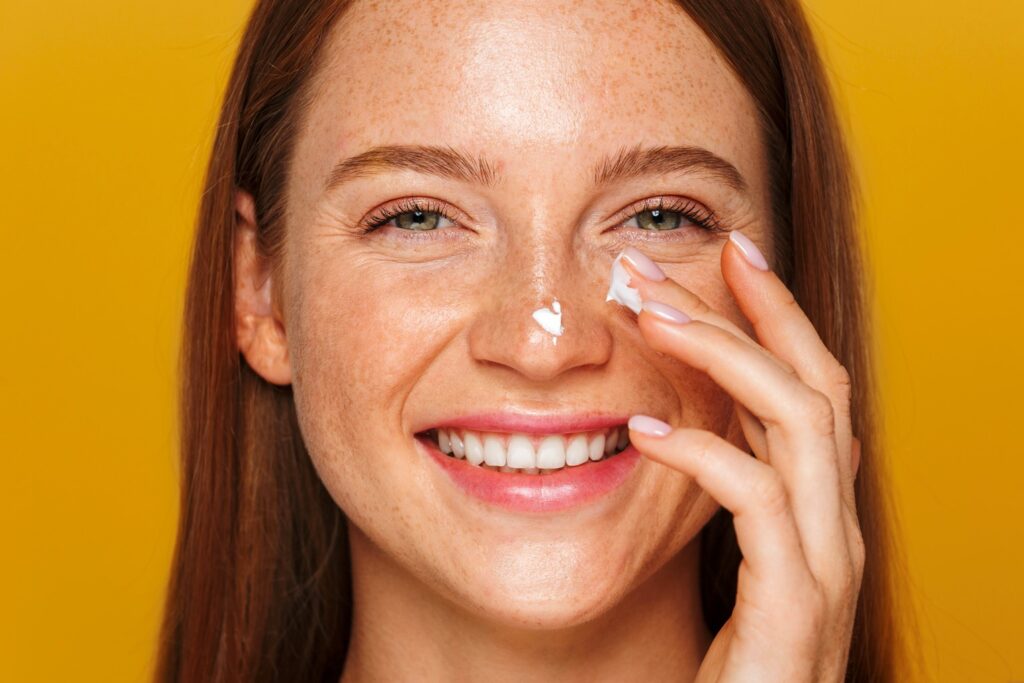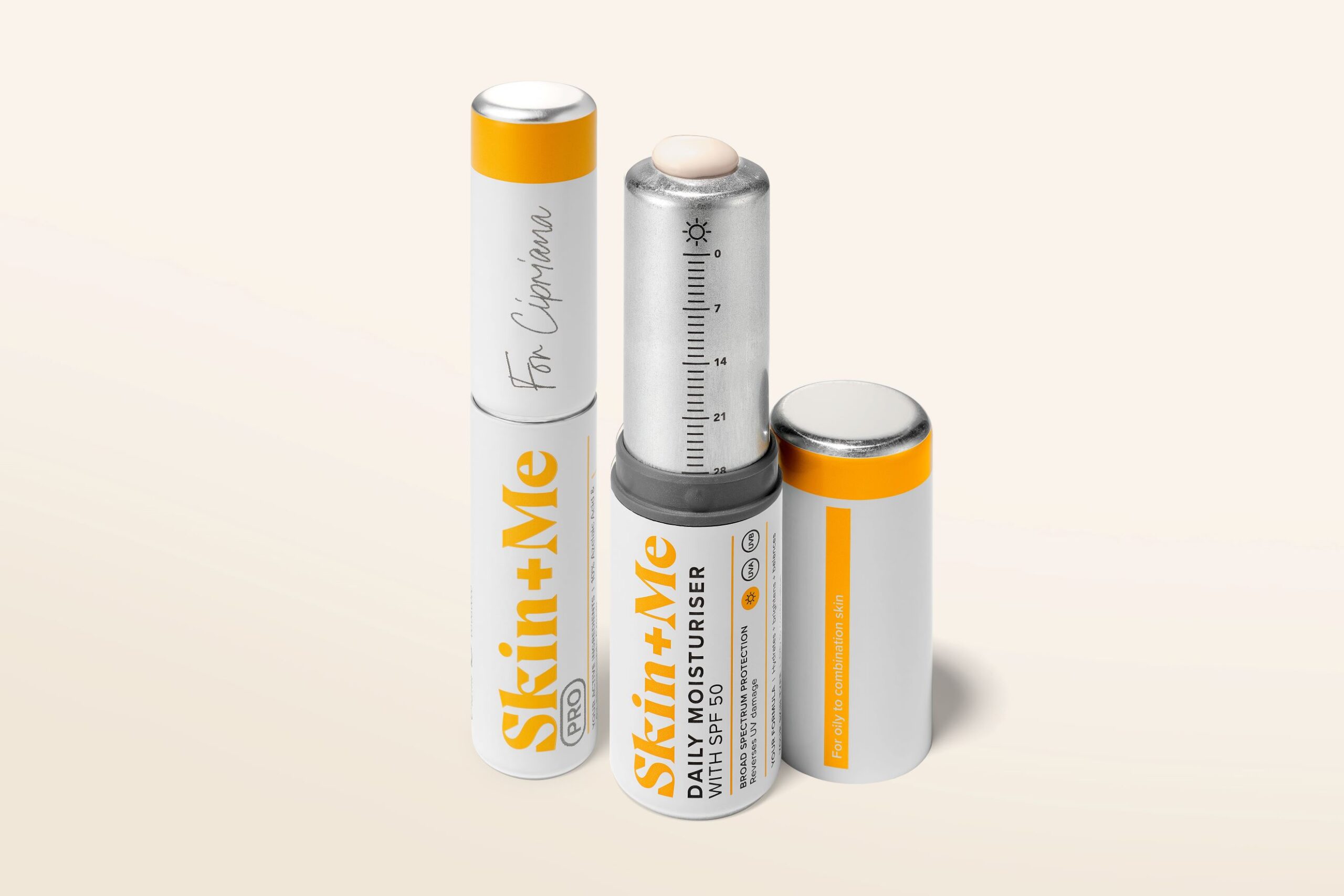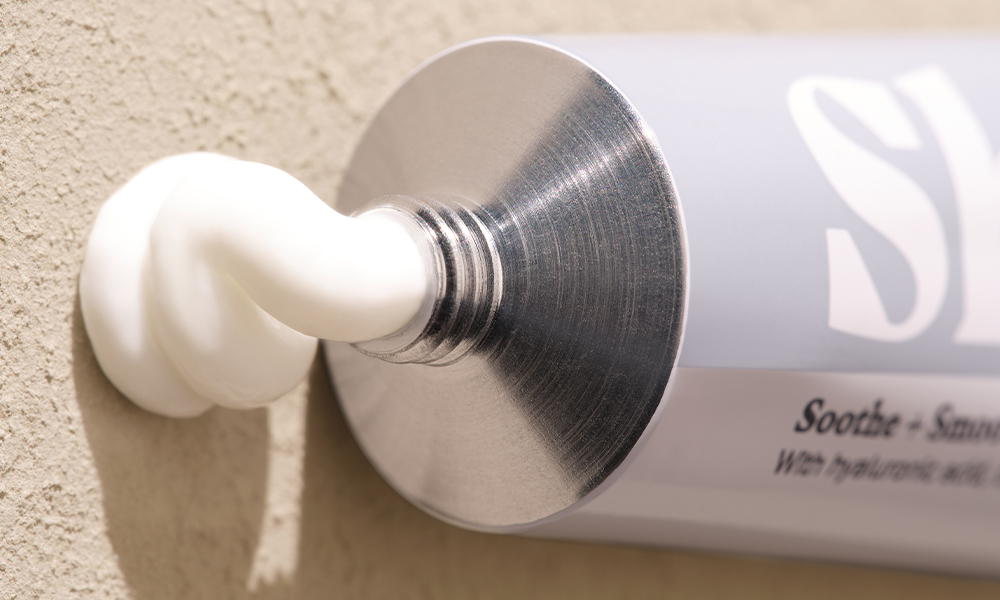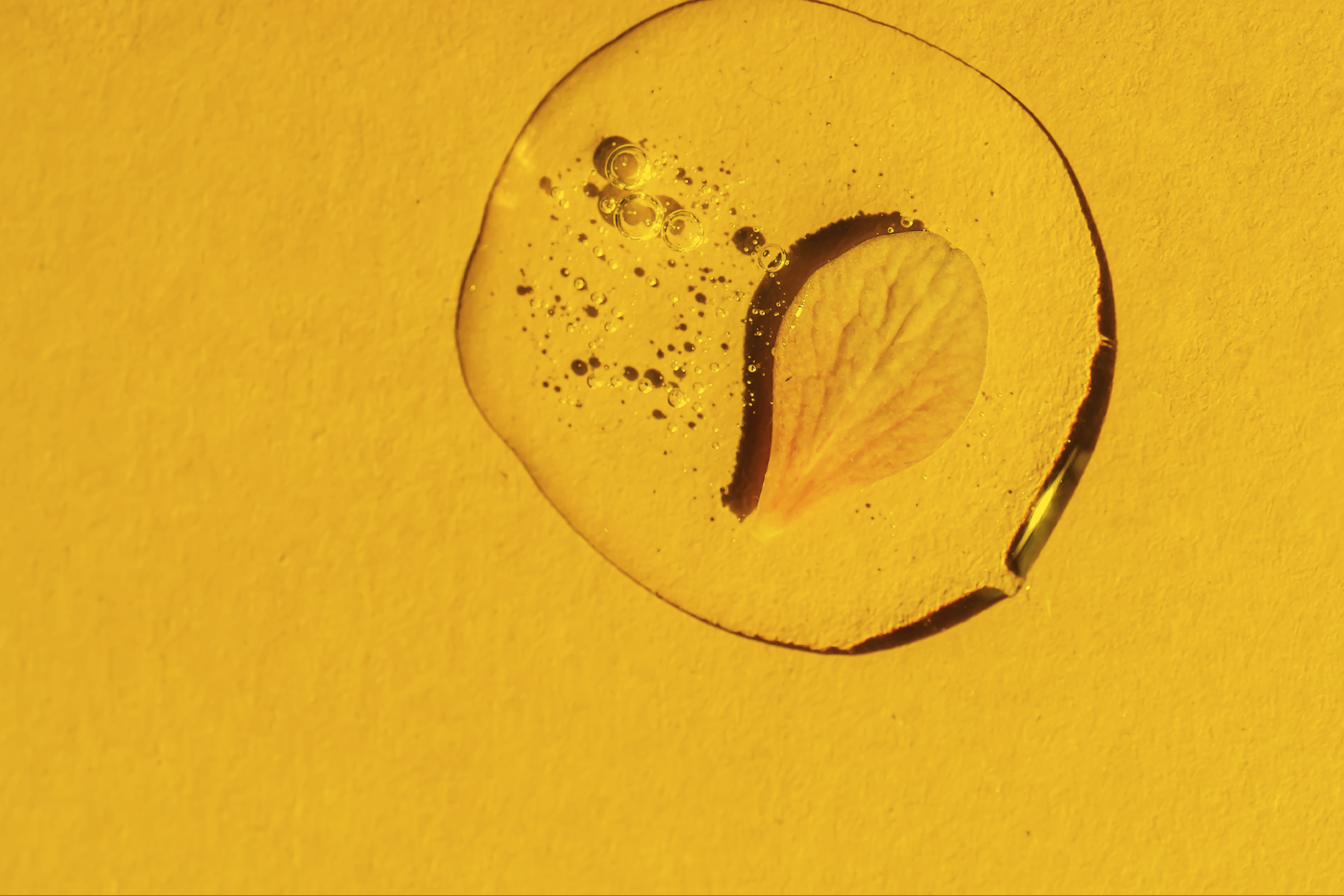Meet the Daily Moisturiser that guarantees SPF 50 – with every click

Link to share article here:
Skincare and the Sun Guide: Freckles, Sun Spots, SPF and Makeup Know-How
Our complicated relationship with skincare and sunshine is as (almost) as old as the sun itself. Just a few decades ago, it was de rigueur to bake outside for hours on end slathered in oil. Today, the healthiest, most fashionable sun-kissed skin only costs the price of glow-enhancing cosmetic products, not the price of our skin health.
Consultant Dermatologist, Dr Malvina Cunningham explains, “It’s good to understand why tanning actually occurs. Tanning is a protective measure for the cells. Melanin is released to try and protect the heart of the cell (nucleus) from UV damage. Although there is a perception that tanned skin is healthy skin it is actually a marker of damage.”
It’s proven that year-round protection against sun damage (hello Skin + Me Daily Defence Oil-free SPF 50 Sunscreen) is indisputably the number one defence we have against developing conditions such as hyperpigmentation and melasma, and the signs of premature ageing. Healthy skin is protected skin.
Causes of sun damage
Leaving your skin unprotected from the sun exposes it to ultraviolet (UV) radiation. This can trigger a damaging chemical reaction that negatively affects the DNA of skin cells leading to inflammation, pigmentation and higher levels of skin ageing.
Symptoms of sun damage
So we know that repeated, unprotected sun exposure is skin’s biggest enemy in the fight against not just ageing skin but conditions such as hyperpigmentation and melasma. How to recognise the symptoms of damage? Take a look below.
+ Hyperpigmentation is due to an increased amount of melanin (a pigment produced by cells within the skin) that causes dark spots or patches to appear on the skin’s surface. Causes of hyperpigmentation include solar lentigos (also called sun spots or age spots), caused by sun exposure.
+ Melasma is the most common cause of hyperpigmentation. Melasma occurs when the melanin-producing cells in our skin are over-stimulated resulting in patches of mottled pigmentation on the skin’s surface. Most cases first occur in our 30s or 40s. The pigmentary changes are often symmetrical. Melasma can be more noticeable in the summer – hormonal changes play a part but UV light is also triggering.
+ Signs of skin-ageing that can be partly attributed to sun exposure appear as fine lines, wrinkles, pigmentation, loss of elasticity and a rough-textured appearance.
Treatment for sun damage conditions
Skin + Me treat hyperpigmentation and melasma, with a personalised formulation containing a combination of evidence-based ingredients. This combination of active ingredients is blended at strengths chosen to give the best results whilst minimising any side effects. Active ingredients may include hydroquinone, tretinoin, hydrocortisone, azelaic acid and niacinamide.
As sun exposure has such a large effect on hyperpigmentation and melasma, it’s also really important to apply regular high factor sunscreen (SPF50+ with UVA and UVB protection) to get the best results with your treatment.
Treatment for sun damage skin-ageing
Heads up! It’s never too late to start using SPF. Skin + Me treat skin-ageing with formulations that can include a combination of retinoic acid, niacinamide and azelaic acid.
Retinoic acid works to thicken the epidermis, reduce pigmentation and restore sun-damaged skin cells. Niacinamide is proven to reduce fine lines, wrinkles and pigmentation, as well as reducing water loss and improving skin elasticity. Finally, azelaic acid slows down the production of melanin and helps to fight age-related pigmentation caused by sun damage.
Where do my freckles come from?
Freckles – your dermatologist may call them ephelides – are extra patches of pigment (melanin) under your skin and you may have them because of your genetic predisposition. Freckles may develop in childhood and continue to show up into your 20s. They’re as beautifully unique as you are and are a normal part of healthy skin.
Freckles that develop in this way aren’t a sign of sun damage in itself. People that have freckles though, are generally more vulnerable to damage from unprotected sun exposure.
The difference between sun-spots and freckles
Both freckles and sunspots are caused by skin pigmentation called melanin – but there’s a difference between them.
People with lighter complexions have less melanin in their skin to begin with. When sunlight triggers their skin to produce more melanin, they can develop freckles instead of getting an even suntan. As a general rule, freckles are common and benign. They’re smaller and lighter in colour than sunspots.
Sunspots appear as flat brown spots on the skin like enlarged freckles, mostly found over sun-exposed areas such as the nose, cheeks and temples but they can appear anywhere on the face as well as your chest and the back of the hands. While most sunspots are harmless they may occasionally change into precancerous or even cancerous lesions. If you notice a spot that stands out compared to others with an irregular shape, varied colours or changing size, go and see your GP to have it checked out.
Should I wear SPF in winter?
In a word, yes. You absolutely should apply sunscreen in winter, spring, summer and autumn. Whether it’s sweltering outside or you’re bundling up to face the frost – sunscreen is essential.
Even if the sun isn’t shining, we know that UV rays can pass through clouds. You could switch to a higher SPF in the summer, particularly if you know you’ll be in the sun for extended periods, but a reliable broad-spectrum SPF 30+ will see you through, all year round.
How to wear daily SPF and makeup together
Daily sun protection is a dermatologist’s non-negotiable. But we’re often asked how best to layer it with makeup. Our Consultant Dermatologist, Dr Malvina Cunningham has the answers.
Skin + Me: Should you apply SPF before or after makeup?
Dr Malvina Cunningham: Sunscreen should be the last product you apply in your morning routine before makeup. After cleansing, apply your serum, mist or moisturisers first and follow with sunscreen.
There are some good tinted sunscreens versions that offer coverage and are great to use instead of makeup. Or opt for a non-tinted version that can be used as a base before you apply makeup.
Skin + Me: How do you choose the right SPF for your skin type? Are some SPFs more ‘make-up friendly’ than others?
Dr Malvina Cunningham: Sunscreens have come a long way in their formulations and there are many different products around. There are light gel formulas that are great for acne-prone skin but be careful as some may pill (gather in patches) under makeup but are great if worn as the last step.
Light lotion sunscreens or liquids are great under makeup. If you have oily skin you often won’t need a moisturiser and the sunscreen can act as a base on its own.
Anyone with dryer or combination skin can opt for richer sunscreens and many new versions on the market come with great additional ingredients such as vitamin C and niacinamide for extra barrier care, and skin ageing protection.
Skin + Me: If your makeup or moisturiser already contains SPF, do we need additional sunscreen? Does layering SPF makeup products increase protection?
Dr Malvina Cunningham: The best thing is to go for a broad spectrum SPF starting at least factor 30. Use a sunscreen product in particular rather than using foundation or moisturiser with SPF to get optimum protection.
The value of SPF is determined in the lab and is based on a large quantity of product. In reality, we apply far less product, and the actual SPF goes down in value. This is even more true when using foundation with SPF as this is typically applied very thinly.
Skin + Me: How do you best protect the delicate skin around your eyes from the sun?
Dr Malvina Cunningham: The eye area is often forgotten but this is such a delicate and susceptible area and it is really important to apply SPF here. Go for products for sensitive skin that are usually tolerated well around the eye. Avoid spray SPF for obvious reasons – although I do like spray formulations for top-ups after makeup has been applied.
Is aftersun worth it?
Skin + Me: How does aftersun work and why is it important to use it?
Dr Malvina Cunningham: Aftersun products are helpful in soothing the skin after a sunburn by relieving pain and reducing inflammation and redness. They cannot, however, reverse the skin damage that has happened as a result of excessive sun exposure, no treatment can. This is why it’s so important to protect your skin from sunburn in the first place through sun avoidance, wearing protective clothing and liberal use of broad spectrum sunscreens.
Skin + Me: What’s better aftersun or aloe vera for sun exposure relief?
Dr Malvina Cunningham: Aloe Vera is a great natural product that can soothe sun-damaged skin. I’d advise going for an aftersun product that contains aloe vera that’s both moisturising and soothing to sun-damaged skin.
Skin + Me: Is aftersun better than moisturiser after time spent in the sun?
Dr Malvina Cunningham: Body moisturisers are helpful for sunburns as they protect the skin from water loss, dryness and irritation. An aftersun product that contains additional ingredients like aloe vera is extra soothing.
Skin + Me: How do you know which consistency to choose? Spray or gel or cream?
Dr Malvina Cunningham: Go for a product that feels the most cooling and soothing, that you can tolerate and doesn’t irritate your sin. Both gel and cream formulations can be great.
The takeaway: A ray of sunshine
A final reminder that although protection is crucial, we’re not advocating for absolute zero exposure.
Exposing our skin to sunlight is key for the production of vitamin D – vital for strong, healthy bones. Sunlight supports the production of the hormone melatonin, which regulates sleep.
Catching a few rays is also thought to supercharge the brain’s mood-boosting release of the hormone, serotonin. There’s no debate here – being out in glorious sunshine just feels so good.
The right attitude here is about adopting healthy, realistic sun-safe lifestyle choices with UV light protection at the fore.
Prevention, not cure is the key. Think regular – every day year-round – wearing of an SPF factor 30 or over.
Our Head of Medical, Dr Jason Thomson explains, “As dermatologists, number one on our list of recommendations is always sunscreen. As the sun’s damaging and premature ageing UV-A rays are constant throughout the year, it means a broad-spectrum sunscreen is still important.”
Luckily, sunscreens have come on in leaps and bounds in the last decade. They’re more effective – and luxurious – to use than ever. For a Dermatologist-designed option, add a tube of Daily Defence Oil-free SPF 50 Sunscreen to your next order here.
Medical facts checked by Consultant Dermatologist, Dr Malvina Cunningham
New to Skin + Me? Get your first month of personalised skincare for £4.99 with promo code DOSE – complete our quick consultation here.
Looking for a routine refresh? Add the Dream Routine to your Skin + Me subscription.
In need of a restock? Head to The Skincare Shop for one-off purchases of your Routine Essentials.



